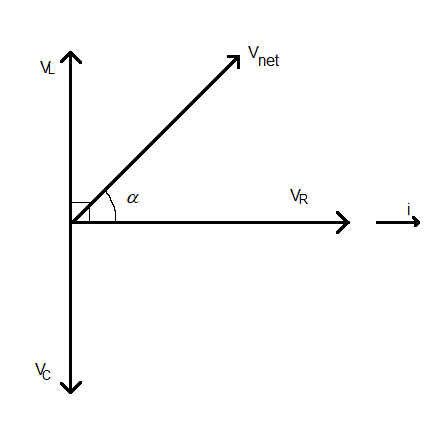
In L-C-R series circuit, power factor at resonance is:
A. less than one
B. greater than one
C. unity
D. cannot predict
Answer
504.9k+ views
Hint: Power factor is the cosine of the angle between net voltage and the current. At resonance, the magnitudes of
Complete step by step answer:
In an AC circuit, the voltage (potential difference) across the components in the circuit and the current flowing in the circuit are treated as vectors. The phase difference between the current and the voltage across the respective component is the angle between the current vector and the voltage vector of the component.
Since the voltage across the resistance and the current are always in phase, the vectors of voltage of resistance (
There is a phase difference of
Therefore, the vector of inductor voltage (
There is a phase difference of
Therefore, the vector of capacitor voltage (
The entire can be summarised with the help of the diagram given below.

Power factor is equal to
At resonance, the magnitudes of
Hence,
Therefore, the value of the power factor for the L-C-R series circuit at resonance is equal to one or unity.
Hence, the correct option is C.
Note: Power factor is defined as the ratio of the power consumed by the circuit (resistance) to the power supplied to by the source of the circuit. In other words, is the ratio of the power of heat generated to the power supplied.
Since at resonance the net voltage is only due to the resistance of the circuit, all the power will be consumed by the resistance. Hence, all the energy will be converted into heat and the value of power factor will be maximum.
Therefore, the value of the power factor is one.
Complete step by step answer:
In an AC circuit, the voltage (potential difference) across the components in the circuit and the current flowing in the circuit are treated as vectors. The phase difference between the current and the voltage across the respective component is the angle between the current vector and the voltage vector of the component.
Since the voltage across the resistance and the current are always in phase, the vectors of voltage of resistance (
There is a phase difference of
Therefore, the vector of inductor voltage (
There is a phase difference of
Therefore, the vector of capacitor voltage (
The entire can be summarised with the help of the diagram given below.

Power factor is equal to
At resonance, the magnitudes of
Hence,
Therefore, the value of the power factor for the L-C-R series circuit at resonance is equal to one or unity.
Hence, the correct option is C.
Note: Power factor is defined as the ratio of the power consumed by the circuit (resistance) to the power supplied to by the source of the circuit. In other words, is the ratio of the power of heat generated to the power supplied.
Since at resonance the net voltage is only due to the resistance of the circuit, all the power will be consumed by the resistance. Hence, all the energy will be converted into heat and the value of power factor will be maximum.
Therefore, the value of the power factor is one.
Recently Updated Pages
Master Class 9 General Knowledge: Engaging Questions & Answers for Success

Master Class 9 English: Engaging Questions & Answers for Success

Master Class 9 Science: Engaging Questions & Answers for Success

Master Class 9 Social Science: Engaging Questions & Answers for Success

Master Class 9 Maths: Engaging Questions & Answers for Success

Class 9 Question and Answer - Your Ultimate Solutions Guide

Trending doubts
Give 10 examples of unisexual and bisexual flowers

Draw a labelled sketch of the human eye class 12 physics CBSE

Differentiate between homogeneous and heterogeneous class 12 chemistry CBSE

Differentiate between insitu conservation and exsitu class 12 biology CBSE

What are the major means of transport Explain each class 12 social science CBSE

a Tabulate the differences in the characteristics of class 12 chemistry CBSE




